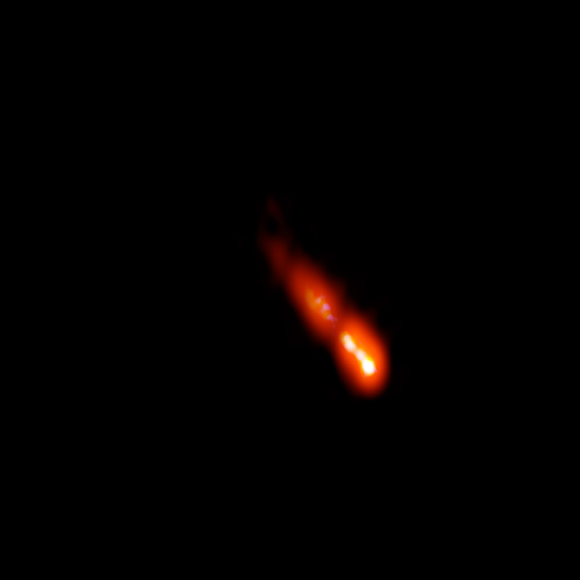Astronomers have observed a bright one-sided jet of material ejected at three-quarters the speed of light from the core of the blazar PSO J030947.49+271757.31 (hereafter PSO J0309+27).
Blazars are active galactic nuclei with relativistic jets of matter speeding towards us almost head-on at the speed of light.
They glow not just with visible light, but with every kind of radiation, from radio waves to gamma rays.
Despite intensive observational and theoretical efforts over several decades, the details of blazar astrophysics remain elusive.
Discovered in 2019, PSO J0309+27 is located some 12.8 billion light-years away from Earth.
The object is seen as it was when the Universe was less than a billion years old, or just over 7% of its current age.
It is the brightest radio-emitting blazar yet seen at such a distance. It also is the second-brightest X-ray emitting blazar at such a distance.
In new research, University of Bologna astronomer Cristiana Spingola and colleagues carried out follow-up observations of PSO J0309+27 with the Karl G. Jansky Very Large Array (VLA) and the Very Long Baseline Array (VLBA).
“In the new image, the brightest radio emission comes from the galaxy’s core, at bottom right,” the researchers said.
“The jet is propelled by the gravitational energy of a supermassive black hole at the core, and moves outward, toward the upper left.”
“The jet seen here extends some 1,600 light-years, and shows structure within it.”
The analysis of PSO J0309+27’s properties provides support for some theoretical models for why blazars are rare in the early Universe.
“If PSO J0309+27 is a genuine blazar, as suggested by its X-ray properties, then we find that its bulk Lorentz factor must be relatively low,” the scientists wrote in their paper.
“This value would be in favor of a scenario currently proposed to reconcile the paucity of high-redshift blazars with current predictions.”
“Nevertheless, we cannot exclude that PSO J0309+27 is seen under a larger viewing angle, which would imply that the X-ray emission must be enhanced, for example, by inverse Compton scattering with the Cosmic Microwave Background.”
“More stringent constraints on the bulk Lorentz factor in PSO J0309+27 and on these factors in the other high-redshift blazars are necessary to test whether their properties are intrinsically different from those of the low-redshift blazar population.”
The findings were published in the journal Astronomy & Astrophysics.
_____
C. Spingola et al. 2020. Parsec-scale properties of the radio brightest jetted AGN at z > 6. A&A 643, L12; doi: 10.1051/0004-6361/202039458








